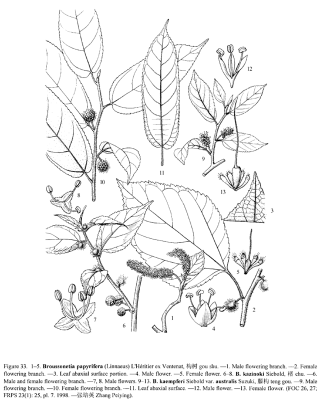Papermakers formerly cultivated their own fields of kozo (Broussonetia papyrifera) but now with rare exceptions, kozo or kazinoki (Broussonetia kazinoki) are grown by farmers in addition to food crops and are sold to paper makers. However, some papermakers still gather together to grow and harvest the bark at the place where paper is manufactured. The paper is produced in many regions of Japan.
Kozo was used early in the manufacture of paper. The earliest papers in Japan (family records of families from Mino - Gifu, Chikuzen – Fukuoka et Buzen – Oita) dating from 702, are kozo papers.
The first great era of paper production in Japan covers the Nara period (710-794) and Heian period (794-1185). During these periods, Japan is dominated by a bureaucracy on the Chinese model that requires the use of large quantities of paper. The practice of copying sutras also requires the production of high quality white paper. The government encourages the establishment of paper mills but they remain under the control of local authorities. Local lords control the production because paper is a ware used as tax. The first papers are produced by the tamezuki method up to the Heian period when they are replaced by the nagashizuki method (see papermaking process).
Techniques improve during the Heian period and kozo and gampi (Wikstroemia) will take the place of hemp. Kozo takes the greatest space because it is easier than hemp and can be grown easily everywhere; gampi has a more limited use because as it could not be cultivated, harvesting is restricted to wild shrubs.
The second great period runs from the Kamakura period (1185-1333) until the end of the Meiji period (1868-1912). The demand for paper increases enormously during the feudal period. Production increases in quantity, quality and variety. During the Edo period (1603-1868), kozo is grown and used in paper manufactures in many parts of Japan. The paper changes its status, from taxes, it takes the status of goods exported to the large cities. This lucrative trade is under the control of the clans of samurais.
The pure kozo paper (choshi) is used for calligraphy, official documents, printing.
Papers for calligraphy are sized to prevent the ink to spread and appear dull and flat. At present papers for calligraphy may contain other fibers such as bamboo or rice straw to expand the range of aesthetic effects to be obtained.
In the arts, kozo papers are used as support for painting, prints, scroll paintings mounting, screens or sliding doors.
They are widely used in homes to cover windows, sliding doors, walls and floors and in different crafts where they are used to make domestic purpose objects, boxes, jars, umbrellas, lanterns, fans, textiles, toys etc
Finally, they are also found in religious or ceremonial articles.
They are also used for making fabrics: the paper sheet is used directly after being treated to increase its strength (Kamiko) or after making threads. The fabric is obtained by weaving mixed threads, paper threads and textiles threads such as silk, cotton or hemp (Shifu).








